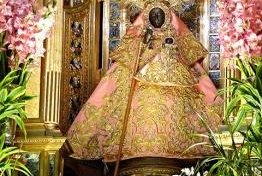
I visited this WHS in June 2015. Last year, returning from my Portugal road trip and passing through Extramadura I had decided that this WHS was too much of a detour eastwards as it is a good 1.5-2hrs away from Merida or Caceres. This time round, I decided to sleep in a motel in Navalcarnero, just outside Madrid, to head for a 2hr 15mins drive early the next morning. I knew that the first tours of the Guadalupe Monastery would be around 10am as the ticket office opens at 09.30. Judging by the Spanish standards of punctuality plus the fact that before a group of at least 10 people is formed, the guide does not start the tour, the first tour will always be after 10am. Yet I woke up early and I arrived in Santa Maria de Guadalupe just after 08:30. The cathedral and monastery are bang in the middle of the town and just behind the monastery is a small free parking lot. There were no cars parked at that hour apart from the few locals who park their vehicle there overnight. The cathedral was open so after admiring the facade I decided to go in to see the interior. At the door there was a sign indicating that mass was going to be celebrated at 08:45 and truly enough the first elderly people started to come in for mass. Being there so early and seeing the intimate nature of the mass celebrated here in honor of the Black Madonna, I decided to attend mass even though my Spanish is very basic. The church is very old and the interior is still decorated/set up in the old traditional way with an iron gate separating the priest and the believers. After mass, I took a couple of photos of the Black Madonna and I went to the book shop to buy the 5 euro ticket for the guided tour. The tour is done in Spanish only unless you happen to be grouped with a busload of English-speaking tourists accompanied by their English-speaking guide. I was happy this was not my case as it meant that only another 9 Spanish tourists came so early on a Sunday morning and at 10.30 we started the tour with 10 people including myself. It's a very good tradeoff in my opinion as the more people there are the more rushed the tour will be and less time will be allowed to actually see the place. Our Spanish guide spoke very slowly which is quite rare in Spain especially with local tourists. This helped me understand the gist of her explanations at least. There are several things to see: what stood out for me were the 100 huge parchment books weighing over 80kg and in pristine condition (similar to the ones in the Yuso/Suso Monasteries), the brass and bronze rotating structure on which these books were placed, important paintings by Zurbaran including his auto-portrait inclusion in the Reliquaries Chapel, Goya's Confessions in Prison and other minor paintings by Rubens and El Greco. Photos are not allowed inside the monastery although our guide let us take pictures of the ornate courtyard and before exiting the Sacristy I managed to take a quick photo of the beautiful frescoes. The Sacristy and Chapel are full of frescoes and church treasures and a great way to end the tour on a positive note. Just before the tour ends, the guide leaves and a Franciscan monk gives a brief overview of the history of the monastery and some information about the Black Madonna of Guadalupe. The monastery was always under the wing of monarchs and has been one of the most important monasteries of Spain for more than 4 centuries. It was at the monastery that the Spanish monarchs Isabel and Ferdinand signed documents that authorized the first voyage of Christopher Columbus to the New World in 1492. After discovering America, Christopher Columbus made his first pilgrimage here. Our Lady of Guadalupe was also the most important Marian shrine in the medieval kingdom of Castile. After his brief explanations the monk opens a wooden door one of the sides of the Reliquaries Chapel and magically revolves what seemed to be an incredibly beautiful and precious golden frame to reveal the Black Madonna and Her Child. Believers can kiss the reliquary and touch the golden threaded garments. Pope John Paul II had visiting this shrine too and there is a painting to commemorate this event which can be seen before going back out to the cloister. The Mudejar details can be easily admired from the cloister and the obvious highlight is the Mudejar Cloister of Miracles. This monastery is really worth visiting for pilgrims and non-pilgrims alike and it is certainly one of Spain's finest.
More on
Comments
No comments yet.
